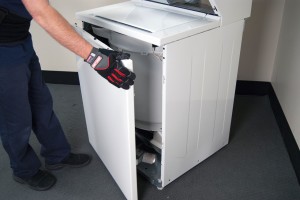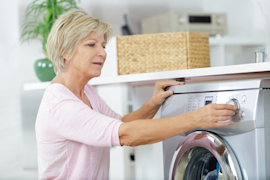- Kenmore refrigerator water filters
- Whirlpool refrigerator water filters
- Samsung refrigerator water filters
- GE refrigerator water filters
- LG refrigerator water filters
- Frigidaire refrigerator water filters
- KitchenAid refrigerator water filters
- Maytag refrigerator water filters
- Kenmore Elite refrigerator water filters
- Estate refrigerator water filters
- GE Profile refrigerator water filters
- Amana refrigerator water filters
- Bosch refrigerator water filters
- Dacor refrigerator water filters
- Electrolux refrigerator water filters
How to fix a washing machine


Laundry piles up quickly when your washer breaks down. You’ll want to fix the washer quickly when it stops working.
What causes a washing machine to stop working?
Many different failures can keep your washer from working. Symptoms such as not powering up or not draining typically point you to the cause of the washer failure.
Here are some of the top failures that plague washers:
Won’t power up. This failure is often caused by a tripped house circuit breaker for the washer’s electrical outlet. Resetting the circuit breaker often restores power to the washer. If the circuit breaker continues to trip after you start using the washer, then a short circuit in a wiring or a component of the washer is likely causing the breaker to trip.
Won’t fill. A failure of the lid switch in a top-load washer or the door switch in the front-load washer can keep the washer from filling. A bad water inlet valve assembly, faulty water level pressure switch, water supply problem, wiring failure or a bad control board or timer can also prevent the clothes washer from filling with water.
Not draining. A clogged house drain, bad drain pump, clogged drain hose or failed control can keep the washer from draining. A bad lid switch can prevent the washer from draining in some top-load washers. Using too much detergent can cause excessive suds. The drain pump often can’t drain the washer properly when water has too much suds.
Won’t spin. A failed lid switch on a top-load washer or a bad door switch on a front-load washer can prevent the washing machine from spinning. An unbalanced load will also keep the washer from spinning.
Washing machine repair troubleshooting
You can often fix washer problems yourself by taking some basic troubleshooting steps. Check your owner’s manual for basic troubleshooting steps to take when something goes wrong with your washing machine. If your washing machine has an electronic control, the control often displays an error code on the control panel when a washer component fails. If you see an error code flashing on your washer’s display, look up the code and follow the troubleshooting steps shown on our washer error code charts.
Here are some general troubleshooting tips to help you fix the common washer failures noted above.
Won’t power up
Check for a tripped circuit breaker. To determine whether the circuit breaker for your washer’s electrical outlet has tripped, unplug the washer and plug a small electrical device such as night light or lamp into the outlet. If the small electrical device doesn’t work, reset the house circuit breaker for your washer. If the small electrical device still doesn’t work after resetting the house circuit breaker, you’ll need to have an electrician fix the outlet or repair the house wiring.
If the breaker wasn’t tripped or the washer won’t power up after resetting the breaker and plugging the washer back in, then the power cord wiring may be disconnected. Unplug the washer and check the power cord wiring connections to the control board. Reconnect any loose or disconnected wires. Plug the washer back in and see if it powers up. If not, then you may need to replace the electronic control board.
Won’t fill
Check the hot and cold water faucets behind the washer to make sure they’re open. In winter, make sure the fill hoses aren’t frozen if you have the washer in a space without climate control. Make sure that you’re getting water flow through the fill hoses by following these steps:
Shut off the hot and cold water faucets behind the washer.
Disconnect the ends of the hot and cold fill hoses that connect to the back of the washer.
Hold the ends of the fill hoses over a bucket and briefly turn on the hot and cold water faucets to check for water flow from the hose ends.
If water doesn’t flow from the fill hose ends, have a plumber repair the water supply going to your washer.
If water does flow from the ends of the fill hoses then you know that the house water supply is okay. Unplug the washer and check the wire harness connections between the control and the water inlet valve assembly. Reconnect any loose or disconnected wires. Check the wiring connections between the control and the lid switch or door switch. Reconnect any loose or disconnected wires. If the wiring connections are all okay, you may need to replace the water inlet valve assembly, the door switch, lid switch, control board or water level pressure switch to fix the fill problem.
Not draining
Remove the hose from the drain stand pipe and pour water down the drain pipe to see whether the house drain for the washer is clogged. If the house drain is clogged, have a plumber clear the drain.
If the house drain for the washer is okay, unplug the washer and check the drain hose for clogs. Clear any clogs in the drain hose.
If the drain hose is okay, check the wiring connections between the control and the drain pump. Reconnect any loose or disconnected wires.
If drain pump wiring connections are okay, a failed drain pump, a bad lid or door switch, or a faulty control could be preventing the washer from draining.
Won’t spin
Check for an unbalanced load. Many washers won’t spin if the load inside the spin basket has shifted to one side of the basket. Evenly distribute load if it’s unbalanced.
A problem with the lid switch or door switch will keep the washer from spinning. Unplug the washer and check the wiring connections between the control and the lid switch or door switch. Reconnect any loose or disconnected wires. If the wiring connections are okay, you may need to replace the switch.
A failed drive motor, broken drive belt or bad control board or timer can also prevent the washer from spinning.
How much does it cost to fix a washing machine?
Fixing a washer problem yourself costs nothing if you don’t need parts to repair the failure.
If you do find a broken part and you can replace the part yourself, the repair cost for fixing the washer will just be the price of the part. The cost of washer parts varies from around $20 to $300 for most washer repairs.
If you need to have a service technician repair the washer, be prepared to pay around $130 for the technician to visit your home and diagnose the failure. Most washer repairs cost between $200 and $300. A major washer repair can cost more than $500.
Most common symptoms to help you fix your washers
Choose a symptom to see related washer repairs.
Main causes: clogged drain hose, house drain clogged, bad drain pump, water-level pressure switch failure, bad control b…
Main causes: worn agitator dogs, bad clutch, broken motor coupler, shifter assembly failure, broken door lock, suspensio…
Main causes: bad lid switch or door lock, bad timer or electronic control board, wiring failure, bad water inlet valve a…
Main causes: broken lid switch or lid lock, bad pressure switch, broken shifter assembly, faulty control system…
Main causes: unbalanced load, loose spanner nut, worn drive block, broken shock absorber or suspension spring, debris in…
Main causes: no water supply, bad water valves, water-level pressure switch failure, control system failure, bad door lo…
Main causes: lack of electrical power, wiring failure, bad power cord, electronic control board failure, bad user interf…
Main causes: leaky water inlet valve, faulty water-level pressure switch, bad electronic control board…
Main causes: water heater failure, bad water temperature switch, faulty control board, bad water valve, faulty water tem…
Most common repair guides to help fix your washers
Effective articles & videos to help repair your washers
Use the advice and tips in these articles and videos to get the most out of your washer.

Find tips for using your washing machine efficiently to save energy and help reduce utility bills.…

Learn about all the convenient features on our Sears PartsDirect website that make your parts purchases easier.…

Get answers to frequently asked questions about Sears and Sears PartsDirect.…